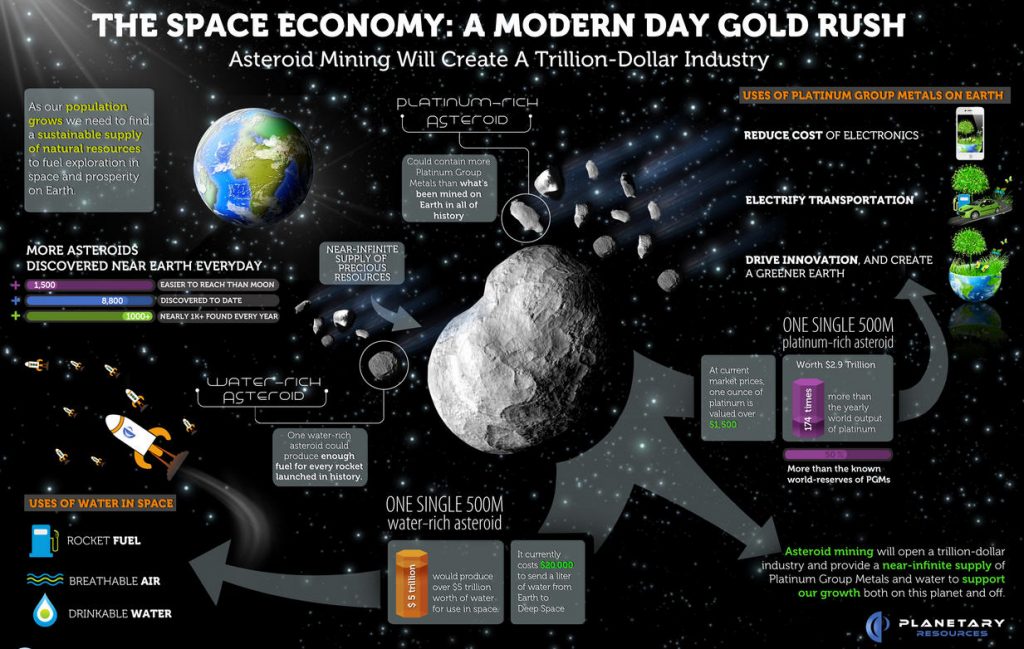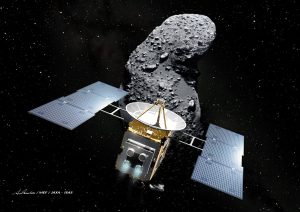
It truly sounds like the stuff of science fiction, but using spacecraft to prospect and mine asteroids in near space is fast becoming science fact. We are well on the way to exhausting planet Earth’s resources. SpaceWatch Middle East contributing editor Helen Jameson, gives her take on Asteroid Mining; Prospecting our Future?
We are fast running out of precious metals and minerals and we could potentially be looking at a situation where we have only 50-60 years of resources left. Space, the next frontier, appears to offer rich rewards for those that are prepared to go and look for resources in space, and asteroids, that are known to have deposited large amounts of their rich materials on Earth over the millennia, are a logical starting point.
Asteroids are rich in minerals and other substances such as gold, silver, platinum, iridium, osmium, palladium, rhenium, tungsten and ruthenium along with substances and gases such as water, ammonia, hydrogen and oxygen. The exploitation of asteroids means that these raw materials could either be used in space to help sustain astronauts for example, or even provide rocket propellant for spacecraft to continue their journey. The other option is to return asteroid material back to Earth for use. However, other options are being discussed that would involve transporting the asteroid to a safe orbit around the moon, Earth or even to the ISS to allow the majority of the materials to be used and not wasted.
JAXA, the Japanese Space Agency, was the first to ever send a spacecraft to the surface of an asteroid. In 2005, the Hayabusa spacecraft landed on the Itokawa asteroid, a near Earth asteroid, and stayed on its surface for 30 minutes before launching itself back off into space and returning to Earth in June 2010 where the re-entry capsule was retrieved from Woomera, Australia. Unfortunately, the sampling sequence was not activated, but despite this, Hayabusa did manage to collect some samples. This was a pioneering mission for JAXA. Further analysis found that the particles that were returned from Itokawa comprised minerals olivine, pyroxene, plagioclase and iron sulphide.
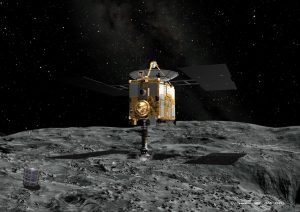
The Itokawa asteroid was an S-Type asteroid, rich in metals. Other types of asteroid include the C-type, which contains a high abundance of water, and the X-type which contains many more times the amount of metals than an S-type. These are the three different types of asteroid that lend themselves to mining.
JAXA and other national space agencies such as NASA have launched a variety of programmes that explore the exploitation of asteroids. For example, NASA’s OSIRIS-REx mission, which was successfully launched in September 2016, is set to arrive at Bennu, a specially selected near-Earth asteroid. The spacecraft will arrive at Bennu in October 2018 and study it in detail before returning with a sample of material from its surface. The analysis of the sample is hoped to enlighten scientists on how planets were formed and how life began. It will also attempt to measure how the tiny push from sunlight can alter the orbit of the asteroid to help scientists to gain more knowledge on whether this could help them to predict the path of asteroids and whether they present any threat to the Earth. NASA also is developing a Robotic Asteroid Prospector Project to examine and evaluate the feasibility of asteroid mining.
But there are some absolutely fascinating developments going on in the private sector, with companies developing their own asteroid mining capabilities. Deep Space Industries and Planetary Resources are leaders in the private asteroid mining field. This is no simple sector to become involved in. Can enough investment be secured? Could this outside sourcing of precious metals and minerals result in lower value is their supply is rapidly increased? This is a new, high-risk industry with long lead-times and, above all, it is not yet proven. There are still enormous question marks that hang over its feasibility. Yet we know the technology is out there and the value of asteroids could be staggering. In September 2016, there were 711 known asteroids with a value exceeding 10 trillion US Dollars. The ten most realistic and best asteroid targets have an estimated value of between 0.06 billion US Dollars and 1250 billion US Dollars.
Luxembourg: The Asteroid Mining Hub
When speaking about asteroid mining, there is one country that comes up in conversation more than any other – and that is Luxembourg. It seems bizarre that this tiny country has put itself at the very centre if the asteroid mining business. However, if the concept of asteroid mining becomes a reality, the truth is that Luxembourg is onto a very lucrative path.
The country already boasts the highest GDP per capita, and is very forward thinking in terms of the fact that it is careful to diversify its industries. The focus on asteroid mining is true evidence of this. In early 2016, the government of Luxembourg announced that it was basically fast-tracking the development of the asteroid mining business by developing a regulatory framework and financial incentives, co-investment in R&D and eventual capital investment for companies that would seek to base themselves within its borders. This would encourage the re-direction of some space companies from Silicon Valley to Luxembourg so that increasing amounts of R&D activity would take place there. Then, in November, Luxembourg passed a law that any private companies based in the country, would be able to keep any resources that they obtained from space, making the prospect of basing themselves there even more attractive.
But it’s not just Luxembourg that is positioning itself as a hub for space resources. It seems that the UAE may be preparing, through legislation, to become an economic exchange for space resources harvested by private companies. In September 2016, The Précis’ Michael Listner, reported that The UAE National Space Policy’s domestic space law: ‘…purportedly addresses both the civil space sector and creates a private interest in commercial space activities, which would fit together with the UAE’s goal of becoming a regional hub of space activities’. It is thought that within the law, there is a provision for the development of a legal and regulatory framework that would support future asteroid mining. This is similar to the Space Resource law passed by the Obama Administration in 2015. This kind of legislation would allow the UAE to become another space resource hub. Listner says: ‘The UAE would also include “space resources” in its domestic space law as a hedge for the law’s acceptance as customary international law, which would allow the UAE to position itself as a legal and economic epicenter for facilitating the acquisition of “space resources” and to act as an economic exchange for their sale.’
However, Luxembourg has taken the first step in pushing through the necessary legal and regulatory framework, and now is at the very forefront of the asteroid mining industry. It does already have experience of hosting commercial space companies such as global satellite operator SES that operates over 50 satellites. One of the companies that it has already succeeded in attracting is Deep Space Industries that has opened a Luxembourg subsidiary.
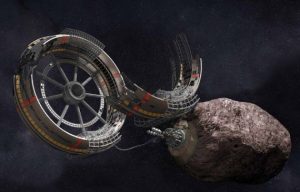
Deep Space Industries (DSI) aims to execute the world’s first commercial interplanetary mining mission with its Proposector-1 spacecraft. Prospector-1 will fly to and rendezvous with a near-Earth asteroid in order to determine its potential for value as a source of space resources. This hugely ambitious project will be preceded by the Prospector-X mission. Excitingly, this is slated for 2017, and will involve the launch of a spacecraft that will demonstrate and test the key technology required for an asteroid mining mission to be completed.
The company, which is partnered with the government of Luxembourg, is focused upon the delivery of an affordable platform that can enable low-cost space exploration. When fuelled the Prospector-1 spacecraft is expected to weight just 50Kg. This, DSI believes, will enable the company to strike the balance between cost and performance and the company is confident that its ducks are in a row in terms of the team and technology.
Water is set to be the first substance to be obtained from an asteroid. The Prospector-1 spacecraft will feature DSI’s Comet water propulsion system, and water mined from any asteroid will enable it to refuel in space, thus creating sustainability. The actual job of selecting an asteroid that holds the most potential in terms of resources will be tackled by a team of experts at DSI. Once Prospector-1 arrives at the target asteroid, it will map the surface and sub-surface, taking visual and infrared imagery and will then use its water thrusters to attempt touchdown on its surface to measure the asteroid’s characteristics.
DSI’s Chairman of the Board, Rick Tumlinson has stressed the importance of being able to effectively ‘live off the land’ in deep space and believes that this will herald an era of unlimited economic expansion.
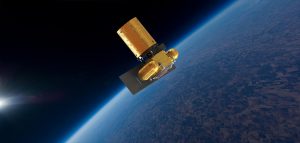
Planetary Resources, another private asteroid mining company, has secured funding from the government of Luxembourg. In June last year, the company signed an agreement with the government that means that it is considering a direct capital investment in the company’s Luxembourg subsidiary. Planetary Resources intends to invest this funding into R&D activities that will enable it to develop its technologies. It is intended that the company’s Earth observation business, Ceres, will generate revenue and intellectual property in Europe and around the world which will further develop the technologies and services required for asteroid prospecting missions. The company has already garnered some big names and investors such as James Cameron and Richard Branson.
https://youtu.be/fJBiZnVsJ7g
Core hardware and software technologies developed at Planetary Resources were tested last year when the Arkyd-3R satellite was deployed from the International Space Station. The company has completed its next spacecraft, the Arkyd-6. This mission will validate the thermographic sensor that will precisely measure temperature differences of objects on Earth, and when deployed on future asteroid missions it will acquire key data related to the presence of water and water-bearing minerals on asteroids.
Also focused, like DSI, on low-cost interplanetary exploration, Planetary Resources has brought all its capabilities under one roof. It has vertically integrated its processes so that 90 percent of its systems are built in-house, helping to keep costs down.
Legal and Regulatory Challenges
The technology to allow asteroid mining is available or in development, but there are a whole host of legal questions that are still to be answered – and this potentially raises a much bigger problem than actually harvesting the resources!
The current legal situation looks like this.
As it stands, the Outer Space Treaty (OST), which was signed in 1967, says that the moon or any other celestial body ‘is not subject to national appropriation by claim of sovereignty’. However, once asteroid mining companies begin operations, the question is who owns the harvested resources? The law passed in the United States in 2015 states that companies that mine the asteroids will be permitted to ‘possess, own, transport, use and sell’ their resources. Luxembourg has also passed a similar law that grants ownership of the resources to the company that mined them. This blatantly violates the OST.
Legal experts are calling for calm and a measured approach to what could result in a myriad of problems. As we have seen, Luxembourg, the UAE and the US are already preparing the ground for asteroid mining activities, and surely it will not stop there. Other countries will be eager to get involved in what is set to be an extremely lucrative business. So, it is vitally important that this does not become a free-for-all. With talk of a base on the moon with 3D printing facilities to equip asteroid mining missions, this is set to become even more complex and challenging. It will be critical to get the legal framework right in the first place, because once it is in place, it is difficult to reverse. This is a very tricky scenario and will demand the coming together of everyone involved to decide upon the best path forward.
A Lucrative Leap into the Unknown?
Low cost interplanetary exploration. Harvesting of space resources. Sustainability in space. It’s hard to believe we are at this point – but we are. Yes it’s risky – very risky and no one can be sure how just how successful it will be. However, facts are facts. Has a spacecraft landed on an asteroid? Yes. Has the spacecraft managed to take a sample from that asteroid? Yes. Has the sample been safely returned to Earth? Yes. The fact that this has been achieved pushes asteroid mining well into the realms of possibility. There are massive challenges ahead. How will the space resources be identified? How can the infrastructure required to process said resources be constructed and maintained? How will the resources be returned to Earth? The technologies are being developed and some already exist. So now it will take companies and bold leaders with great ambition to ensure that this becomes a reality. In the long-term, this could herald massive opportunity for small countries, like Luxembourg, to become involved in and diversify their economy through asteroid mining.
For the pioneers, DSI and Planetary Resources, this is the time. Talk is truly turning to space for all sorts of reasons, but given the situation here on Earth, where resources are depleting rapidly, they are presenting what appears to be a realistic alternative. This is an extremely exciting time where, in the coming years, perhaps even this year, we will see some major developments that put mankind on the road to successful mining of asteroids.
Even more pressing than the technology is the legal framework that will govern asteroid mining activities. If it is not right, it could be hugely damaging and could even result in political tensions as increasing amounts of countries become involved.
As with everything in space, things take time, but there is the appetite to make this a success with famous backers and a government like Luxembourg that is prepared to put its neck on the line to make the sector a reality – and quickly. With the majority of funding coming from the private sector, and through international partnerships such as the one signed between DSI and MxSpace, it certainly gives the feeling that there is a quite solid chance of success.
Asteroid mining? What a time to be alive!
Original published at: http://spacewatchme.com/2017/02/asteroid-mining-prospecting-future/
 SpaceWatch.Global An independent perspective on space
SpaceWatch.Global An independent perspective on space

